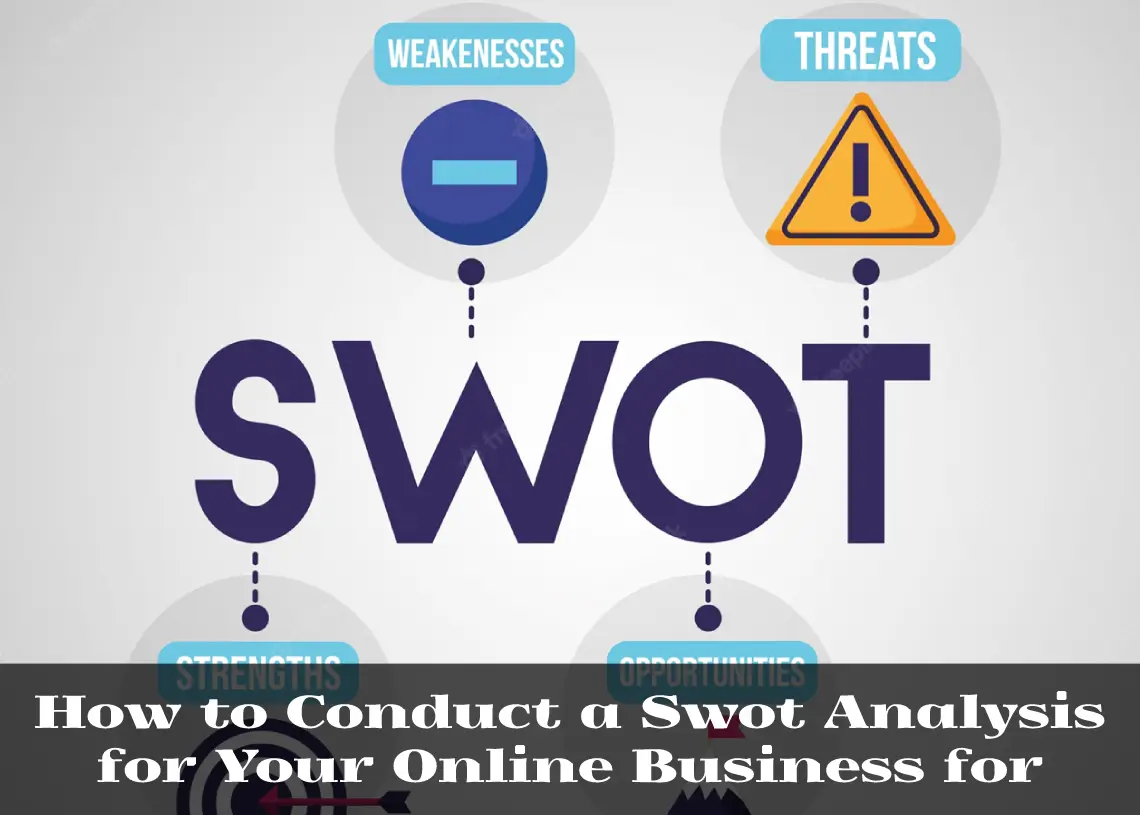Conducting a Swot Analysis for your online business is a great way to identify and understand your business’ strengths and weaknesses, as well as to recognize opportunities and threats that can affect its future success. It is an essential part of the business planning process, and it requires a comprehensive review of all aspects of your business. In this blog post, we’ll discuss what a SWOT Analysis is, its benefits, how to conduct one, and how to use its results to your advantage.
Introduction to SWOT Analysis
A SWOT Analysis is an acronym for Strengths, Weaknesses, Opportunities, and Threats. It is a strategic planning tool used to evaluate the internal and external factors that influence the success of a business. This analysis helps to identify potential obstacles and setbacks that could affect a business’s growth, as well as opportunities that can help it reach its goals. It is also a useful tool for understanding the competitive environment and its impact on the business.
By conducting a thorough SWOT Analysis, businesses can gain a better understanding of their current situation and develop strategies to address their weaknesses, capitalize on their strengths, exploit opportunities, and mitigate threats. SWOT Analysis is a valuable tool for businesses of all sizes, from small businesses to large corporations.
What is SWOT Analysis?
A SWOT Analysis is a process that evaluates an organization’s strengths, weaknesses, opportunities, and threats. It is a systematic approach to analyzing the internal and external factors that can affect the success of a business. It helps to identify potential obstacles and opportunities and to develop strategies to address them.
The SWOT Analysis process begins with gathering information about the business and its environment. This includes researching the company’s financials, customer and supplier relations, competitors, industry trends, and the external environment. The next step is to analyze the data and identify the strengths and weaknesses of the business, as well as any potential opportunities or threats.
Once the strengths, weaknesses, opportunities, and threats have been identified, the next step is to develop strategies to capitalize on the strengths, address weaknesses, exploit opportunities, and mitigate threats. Finally, the strategies should be implemented and tracked to ensure that they are successful.
Benefits of Conducting a SWOT Analysis
Conducting a SWOT Analysis has many benefits. It helps to identify potential obstacles and opportunities that can affect the success of a business. It can also help to identify areas of the business that need improvement and develop strategies to address them.
A SWOT Analysis can also provide insight into the competitive environment and its impact on the business. It can help to identify potential competitors and their strategies, as well as any opportunities or threats that could arise from them.
Finally, a SWOT Analysis can provide a business with a better understanding of its current situation and help it develop strategies to capitalize on its strengths and address its weaknesses. It can also help to identify potential opportunities and threats that can affect the success of the business.
How to Conduct a SWOT Analysis
Conducting a SWOT Analysis is not difficult. It begins with researching the company and its environment. This includes gathering information about the company’s financials, customer and supplier relations, competitors, industry trends, and the external environment.
Once the information is gathered, the next step is to analyze it and identify the strengths and weaknesses of the business, as well as any potential opportunities or threats. This requires a comprehensive review of the data that was collected.
Once the strengths, weaknesses, opportunities, and threats have been identified, the next step is to develop strategies to capitalize on the strengths, address weaknesses, exploit opportunities, and mitigate threats. These strategies should be specific, measurable, achievable, and realistic.
Step by Step Guide to Conducting a SWOT Analysis
Conducting a SWOT Analysis is a straightforward process. Here is a step-by-step guide to conducting a SWOT Analysis for your online business:
- Gather Information: Begin by gathering information about the company and its environment. This includes researching the company’s financials, customer and supplier relations, competitors, industry trends, and the external environment.
- Analyze Information: Once the information is gathered, analyze it to identify the strengths and weaknesses of the business, as well as any potential opportunities or threats.
- Develop Strategies: Once the strengths, weaknesses, opportunities, and threats have been identified, develop strategies to capitalize on the strengths, address weaknesses, exploit opportunities, and mitigate threats.
- Implement Strategies: Implement the strategies and track their progress to ensure success.
- Monitor Progress: Monitor the progress of the strategies and make adjustments as necessary.
Master SWOT Analysis & Business Strategy for Ongoing Success!
Analyzing Each Element of the SWOT Analysis
Once the strengths, weaknesses, opportunities, and threats have been identified, it is important to analyze each element in detail. This will help to gain a better understanding of each element and how it can affect the success of the business.
- Strengths: Strengths are the internal aspects of the business that give it an advantage over its competitors. These include things such as its financial resources, skilled workforce, superior products or services, and strong customer relationships.
- Weaknesses: Weaknesses are the internal aspects of the business that can hinder its success. These include things such as inadequate financial resources, lack of skilled workforce, inferior products or services, and weak customer relationships.
- Opportunities: Opportunities are external factors that can help the business reach its goals. These include things such as market trends, new technologies, and changing customer needs.
- Threats: Threats are external factors that can hinder the success of the business. These include things such as competition, changing regulations, and economic conditions.
Capitalizing on Your Strengths
Once the strengths of the business have been identified, it is important to capitalize on them. This can be done by leveraging the strengths to create a competitive advantage. For example, if the business has a strong customer base, it can use this to its advantage by offering special discounts or promotions to its customers.
It is also important to invest resources into the areas of the business that are strong. This can include investing in research and development, training, and marketing. These investments can help to strengthen the business and give it an edge over its competitors.
Overcoming Your Weaknesses
Once the weaknesses of the business have been identified, it is important to address them. This can be done by making changes in the areas where the business is weak. For example, if the business has a weak customer base, it can invest in customer acquisition strategies such as advertising and promotions.
It is also important to invest resources in the areas of the business that are weak. This can include investing in training for the workforce, improving customer service, and investing in research and development. These investments can help to strengthen the weak areas of the business and make it more competitive.
Exploiting Opportunities
Once the opportunities of the business have been identified, it is important to exploit them. This can be done by taking advantage of the external factors that can help the business reach its goals. For example, if market trends are indicating an increase in demand for a certain product or service, the business can capitalize on this by offering the product or service.
It is also important to invest resources in areas of the business that have potential opportunities. This can include investing in research and development, training, and marketing. These investments can help to position the business in the best possible way to capitalize on the opportunities.
Identifying and Mitigating Threats
Once the threats of the business have been identified, it is important to address them. This can be done by making changes to the business to mitigate the threats. For example, if the business is facing competition from a new competitor, it can invest in marketing and promotions to help it stand out from the competition.
It is also important to invest resources in the areas of the business that are vulnerable to threats. This can include investing in research and development, training, and marketing. These investments can help to make the business more competitive and reduce the risk of threats.
Conclusion: Conduct a Swot Analysis for Your Online Business!
Conducting a SWOT Analysis for your online business is a great way to identify and understand your business’s strengths and weaknesses, as well as to recognize opportunities and threats that can affect its success. It is an essential part of the business planning process and can provide valuable insight into the competitive environment and its impact on the business. By conducting a thorough SWOT Analysis, businesses can gain a better understanding of their current situation and develop strategies to address their weaknesses, capitalize on their strengths, exploit opportunities, and mitigate threats.
With this blog post, we hope we have clarified the concept of SWOT Analysis and provided you with the information you need to conduct a successful SWOT Analysis for your online business. By following the steps outlined in this blog post, you will be able to identify and capitalize on your business’s strengths, address its weaknesses, exploit opportunities, and mitigate threats.




